
- There was a time when both megalodon sharks and great whites co-existed.
- Both species ooccupied the same position in the food chain.
- It's likely that the existence of great whites caused the extinction of megalodons.
An examination of the zinc content of teeth from sharks both living and extinct is providing clues about the demise of the largest-known shark, indicating the mighty megalodon may have been out-competed by the great white shark in ancient seas.
Researchers assessed the ratio of two forms of the mineral zinc in an enamel-like material called enameloid that comprises the outer part of shark teeth. This ratio enabled them to infer the diets of the sharks and gauge their position on the marine food chain.
They found that while the megalodon may have been alone atop the food chain for millions of years, the great white shark's arrival about 5.3 million years ago added another apex predator hunting similar prey.
This competition for food resources featured two animals now lodged in the popular imagination - with the great white featured in the blockbuster 1975 film Jaws and its sequels and the megalodon starring in the popular 2018 movie The Meg.
Megalodon, whose scientific name is Otodus megalodon, appeared about 15 million years ago and went extinct about 3.6 million years ago. It was one of the largest predators in Earth's history, reaching at least 15 metres and possibly 20 metres in length while feeding on marine mammals including whales.
The great white shark, Carcharodon carcharias, reaches at least 6 metres long, and may have been the more agile of the two.
"The megalodon co-existed with the great white shark during the time frame called the early Pliocene, and our zinc data suggest that they seem to have indeed occupied the same position in the food chain," said paleobiologist Kenshu Shimada of DePaul University in Chicago, a co-author of the study published on Tuesday in the journal Nature Communications.
"There have been multiple hypotheses as to why megalodon went extinct. Traditional hypotheses have attributed this to climate change and the decline in food sources. However, a recently proposed hypothesis contends that megalodon lost the competition with the newly evolved great white shark. Our new study appears to support this proposition. It is also entirely possible that a combination of multiple factors may have been at play," Shimada said.
The researchers said it is not thought that the great white actually hunted its larger cousin.
The study involved teeth from 20 living shark species and 13 fossil species, signaling their position on the food chain.
"At the bottom of the food chain are our 'primary producers,' which are photosynthetic organisms like phytoplankton that convert solar energy to food. At the top of the food chain are the apex predators like great white sharks, who have no predators except for humans, while in between we have herbivores, omnivores and lower-level carnivores," said study co-author Michael Griffiths, a geochemist and paleoclimatologist at William Paterson University in New Jersey.
Today's great white sharks hunt sea turtles as well as marine mammals including seals, sea lions, porpoises, dolphins and small whales.
The study indicated that Carcharodon hastalis, considered a direct ancestor of the great white, was not positioned as high in the food chain, likely feeding commonly on fish rather than marine mammals.
For a creature that played a vital role in marine ecosystems for millions of years, much remains mysterious about the megalodon. Because shark skeletons are cartilaginous rather than bony, they do not lend themselves well to fossilization, making it hard to know precisely what megalodon looked like. However, innumerable megalodon tooth fossils have been found around the world.
"Megalodon is typically portrayed as a super-sized, monstrous shark in novels and films, but the reality is that we still know very little about this extinct shark," Shimada said.


